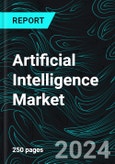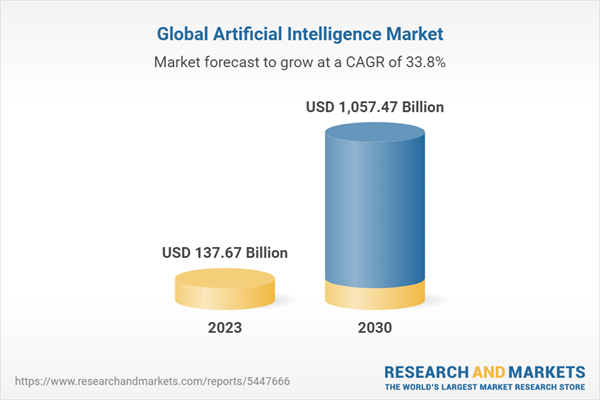Global Artificial Intelligence Market is anticipated to increase at a CAGR of 33.81% during the forecast period of 2024 to 2030
The surge in adopting autonomous synthetic intelligence (AI) is propelling a good-sized market increase. Autonomous AI systems, geared up with machine learning and deep learning capabilities, can function independently and adapt to changing environments. These structures provide remarkable performance and accuracy in tasks, including facts evaluation, decision-making, and procedure automation across manufacturing, transportation, and healthcare industries. As agencies increasingly leverage autonomous AI to power innovation and competitive advantages, the demand for such technology continues to skyrocket, fueling the expansion of the artificial intelligence market.Also, the growth in market demand for intelligent systems to improve efficiency and productivity is propelling the expansion of the global artificial intelligence market. Technological advancements in the artificial intelligence market, such as rapid speech and natural language processing, influence the market's growth. Artificial intelligence, generally called machine intelligence, is an area of computer science that focuses on increasing and managing technology that can remember to make choices and independently perform transactions on behalf of humans. Also, tech businesses are growing their product offerings and services to broaden their global obtainability. Hence, the global artificial intelligence market was US$ 137.67 Billion in 2023.
Research scientists are increasingly embracing artificial intelligence technology due to its transformative talents. This trend is anticipated to be maintained in the coming years while presenting a possibility for the artificial intelligence market to become more prominent. Technology hurries information evaluation, identifies styles, and facilitates complicated simulations, permitting breakthroughs across diverse sectors. AI-powered equipment streamlines repetitive tasks, freeing scientists to focus on innovation. In many fields, research scientists have begun appreciating the importance and capacity of AI to predict effects, find hidden insights, and optimize experiments. The scientific community acknowledges AI's role in amplifying research performance and propelling discoveries, leading to a more symbiotic relationship between technology and human information.
The artificial intelligence market is witnessing significant growth in software solutions
By solution, the global artificial intelligence is fragmented into Hardware, Software (AI Applications, AI System Infrastructure Software, AI Application Development & Deployment, and Artificial Intelligence Platforms), and Services. Software solutions are experiencing a significant increase in the artificial intelligence market. This is because of their versatility, scalability, and cost-effectiveness. The AI software program offers various packages, from natural language processing and image recognition to predictive analytics and robot process automation. This flexibility permits companies to tailor AI solutions to their needs, propelling adoption across numerous finance, healthcare, and retail sectors. Furthermore, the accessibility of cloud-based AI platforms democratizes access to advanced AI competencies, spurring fast growth in the software phase of the AI market.AI applications lead the software programs in the market due to their various functionalities and vast applicability across industries. From virtual assistants to predictive analytics, AI applications offer tangible solutions to complex issues, driving their prominence and dominance in the market.
Artificial intelligence industry is anticipated to witness substantial growth in deep learning technology
By technology, the global artificial intelligence is segmented into Deep Learning, Natural Language Processing (NLP), Machine Learning, and Machine Vision. Deep learning technology is projected to grow tremendously in the artificial intelligence market in the forecast duration. Its potential to analyze massive datasets and derive complex techniques autonomously makes it beneficial across industries like healthcare, finance, and independent motors. As groups increasingly harness deep learning for advanced programs like image recognition and natural language processing, its adoption is predicted to surge, driving growth in the artificial intelligence market.Advertising and media industry is expected to take the lead in the global market
By end-user, the global artificial intelligence is divided into Healthcare, BFSI, LAW, Retail, Advertising & Media, Automotive & Transportation, Agriculture, Manufacturing, and Others. The advertising and media sector is poised to lead the worldwide market. This is due to its high demand for personalized and centered content. AI technology, like machine learning algorithms and natural language processing, permits unique audience concentration, content optimization, and real-time analytics. With advertisers and media agencies prioritizing data-driven strategies to enhance patron engagement and ROI, the adoption of AI solutions is expected to surge, propelling the advertising and media section's leadership in the market.United States dominated the global market for artificial intelligence
By countries, the global artificial intelligence market is classified into North America (United States, Canada), Europe (France, Germany, Italy, Spain, United Kingdom, Belgium, Netherlands, and Turkey), Asia Pacific (China, Japan, India, Australia, South Korea, Thailand, Malaysia, Indonesia, and New Zealand), Latin America (Brazil, Mexico, and Argentina), Middle East & Africa (South Africa, Saudi Arabia, and UAE). The United States is anticipated to have a sizable market for artificial intelligence. This is due to federal investments in advanced technology that have helped create a robust innovation ecosystem.In recent years, scientists and entrepreneurs from everywhere in the world, as well as renowned research centers, have come collectively to the United States to boost the development of AI. The US authorities have several AI-associated tasks, including the Expanding AI Innovation via Capacity Building and Part II software launched by the National Science Foundation in December 2022. The program aims to increase under represented companies' participation in AI learning, research, and workforce improvement through capability-building projects and collaboration.
Key Players
The leading companies in the global artificial intelligence market are Microsoft Corporation, IBM Corporation, Amazon, Baidu Inc., Nvidia Corporation, Oracle Corporation, Hewlett Packard Enterprise, Intel Corporation, Salesforce Inc., and Alphabet Inc.In February 2023 - NVIDIA recently launched the NVIDIA DGX Cloud, which provides companies with access to the DGX AI supercomputer for their AI models. The DGX Cloud is currently available through the Oracle Cloud infrastructure and will soon be accessible on other cloud platforms such as Microsoft Azure, GCP, and others.
The report titled “Global Artificial Intelligence Market By Solution (Hardware, Software (AI Applications, AI System Infrastructure Software, AI Application Development & Deployment, and Artificial Intelligence Platforms), and Services), Technology (Deep Learning, Natural Language Processing (NLP), Machine Learning, and Machine Vision), End-User (Healthcare, BFSI, LAW, Retail, Advertising & Media, Automotive & Transportation, Agriculture, Manufacturing, and Others),Countries (North America (United States, Canada), Europe (France, Germany, Italy, Spain, United Kingdom, Belgium, Netherlands, and Turkey), Asia Pacific (China, Japan, India, South Korea, Thailand, Malaysia, Indonesia, Australia, and New Zealand), Latin America (Brazil, Mexico, and Argentina), Middle East & Africa (Saudi Arabia, UAE, and South Africa)), Company Analysis (Microsoft Corporation, IBM Corporation, Amazon, Baidu Inc., Nvidia Corporation, Oracle Corporation, Hewlett Packard Enterprise, Intel Corporation, Salesforce Inc., and Alphabet Inc.)” provides a complete study of the Global Artificial Intelligence Industry.
Solution - Global Artificial Intelligence Market breakup in 3 viewpoints:
1. Hardware2. Software
2.1 AI Applications
2.2 AI System Infrastructure Software
2.3 AI Application Development & Deployment
2.4 Artificial Intelligence Platforms
3. Services
Technology - Global Artificial Intelligence Market breakup in 4 viewpoints:
1. Deep Learning2. Natural Language Processing (NLP)
3. Machine Learning
4. Machine Vision
End-User - Global Artificial Intelligence Market breakup in 9 viewpoints:
1. Healthcare2. BFSI
3. LAW
4. Retail
5. Advertising & Media
6. Automotive & Transportation
7. Agriculture
8. Manufacturing
9. Others
Countries - Global Artificial IntelligenceMarket breakup in 25 viewpoints:
1. North America1.1 United States
1.2 Canada
2. Europe
2.1 France
2.2 Germany
2.3 Italy
2.4 Spain
2.5 United Kingdom
2.6 Belgium
2.7 Netherland
2.8 Turkey
3. Asia Pacific
3.1 China
3.2 Japan
3.3 India
3.4 South Korea
3.5 Thailand
3.6 Malaysia
3.7 Indonesia
3.8 Australia
3.9 New Zealand
4. Latin America
4.1 Brazil
4.2 Mexico
4.3 Argentina
5. Middle East & Africa
5.1 Saudi Arabia
5.2 UAE
5.3 South Africa
All the Key players have been covered from 3 Viewpoints:
- Overview
- Recent Development
- Revenue Analysis
Company Analysis:
1. Microsoft Corporation2. IBM Corporation
3. Amazon
4. Baidu Inc.
5. Nvidia Corporation
6. Oracle Corporation
7. Hewlett Packard Enterprise
8. Intel Corporation
9. Salesforce Inc.
10. Alphabet Inc.
Table of Contents
Companies Mentioned
- Microsoft Corporation
- IBM Corporation
- Amazon
- Baidu Inc.
- Nvidia Corporation
- Oracle Corporation
- Hewlett Packard Enterprise
- Intel Corporation
- Salesforce Inc.
- Alphabet Inc.
Methodology
In this report, for analyzing the future trends for the studied market during the forecast period, the publisher has incorporated rigorous statistical and econometric methods, further scrutinized by secondary, primary sources and by in-house experts, supported through their extensive data intelligence repository. The market is studied holistically from both demand and supply-side perspectives. This is carried out to analyze both end-user and producer behavior patterns, in the review period, which affects price, demand and consumption trends. As the study demands to analyze the long-term nature of the market, the identification of factors influencing the market is based on the fundamentality of the study market.
Through secondary and primary researches, which largely include interviews with industry participants, reliable statistics, and regional intelligence, are identified and are transformed to quantitative data through data extraction, and further applied for inferential purposes. The publisher's in-house industry experts play an instrumental role in designing analytic tools and models, tailored to the requirements of a particular industry segment. These analytical tools and models sanitize the data & statistics and enhance the accuracy of their recommendations and advice.
Primary Research
The primary purpose of this phase is to extract qualitative information regarding the market from the key industry leaders. The primary research efforts include reaching out to participants through mail, tele-conversations, referrals, professional networks, and face-to-face interactions. The publisher also established professional corporate relations with various companies that allow us greater flexibility for reaching out to industry participants and commentators for interviews and discussions, fulfilling the following functions:
- Validates and improves the data quality and strengthens research proceeds
- Further develop the analyst team’s market understanding and expertise
- Supplies authentic information about market size, share, growth, and forecast
The researcher's primary research interview and discussion panels are typically composed of the most experienced industry members. These participants include, however, are not limited to:
- Chief executives and VPs of leading corporations specific to the industry
- Product and sales managers or country heads; channel partners and top level distributors; banking, investment, and valuation experts
- Key opinion leaders (KOLs)
Secondary Research
The publisher refers to a broad array of industry sources for their secondary research, which typically includes, however, is not limited to:
- Company SEC filings, annual reports, company websites, broker & financial reports, and investor presentations for competitive scenario and shape of the industry
- Patent and regulatory databases for understanding of technical & legal developments
- Scientific and technical writings for product information and related preemptions
- Regional government and statistical databases for macro analysis
- Authentic new articles, webcasts, and other related releases for market evaluation
- Internal and external proprietary databases, key market indicators, and relevant press releases for market estimates and forecasts

LOADING...
Table Information
| Report Attribute | Details |
|---|---|
| No. of Pages | 250 |
| Published | February 2024 |
| Forecast Period | 2023 - 2030 |
| Estimated Market Value ( USD | $ 137.67 Billion |
| Forecasted Market Value ( USD | $ 1057.47 Billion |
| Compound Annual Growth Rate | 33.8% |
| Regions Covered | Global |
| No. of Companies Mentioned | 10 |









